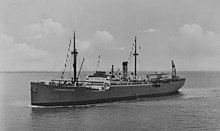Catapult ship


A catapult ship is the name given to ships that were able to throw float planes and flying boats into the air with an airplane catapult .
German catapult ships
Ernst Heinkel , the founder of Ernst Heinkel Flugzeugwerke , began testing on- board catapults in 1927 . They enabled on-board aircraft ( HE 12 , HE 58 ) of high-speed steamers on the America route to save more than 24 hours by flying ahead with the mail.
Before the Second World War, the German Lufthansa used four catapult ships to launch their flying boats for mail and passenger service to West Africa and South America. From 1934 the Westfalen and Schwabenland , both converted freighters, were used in the South American service. In 1936 the Ostmark followed , the first Lufthansa ship specially built as a catapult ship, and in 1937 the Friesenland . The Schwabenland was used as an expedition ship for the German Antarctic Expedition 1938/39 , which for the first time explored and measured large areas of the Antarctic using airplanes.
All four catapult ships were taken over by the Luftwaffe during World War II and used for military purposes. The Luftwaffe also had three of its own catapult ships - called slingshots - built between 1938 and 1942 . In 1938 the Sperber was put into service; it was followed in 1942 by the larger units buzzard and falcon .
British catapult ships
From 1941 to 1943, a total of 35 freighters equipped with rocket-propelled catapults were used in the British Royal Navy as an emergency solution to secure trade convoys . These CAM ships ( Catapult Aircraft Merchantmen ) had the catapult set up on the bow and could only start the one fighter plane carried on the catapult to defend against German aircraft.
See also
literature
- Erich Gröner , Dieter Jung and Martin Maass: The German warships 1815-1945. Volume 7: Landing Associations. Bernard and Graefe, Bonn 1990, ISBN 3-7637-4807-5 .
- Jörg-M. Hormann: Flight log Atlantic. German catapult flights 1927–1939. Delius Klasing, Bielefeld 2007, ISBN 978-3-7688-1973-2 .
- Dieter Jung, Berndt Wenzel, Arno Abendroth: The ships and boats of the German sea pilots. 1912-1976. Motorbuch-Verlag, Stuttgart 1977, ISBN 3-87943-469-7 .
- Simon Mitterhuber: The German catapult planes and slingshots. Development, use and technology. Bernard & Graefe, Bonn 2003, ISBN 3-7637-6244-2 .
- Elmar Wilczek: German slingshots, Heinkel catapults and catapult flying boats. In: air and sea. Issue 3, 2008, ZDB -ID 540595-6
Web links
- Air Force Catapult Ships
- Historical naval archive: ships and boats of the Air Force
- Air Force catapult ships
- Image of the catapult ship Ostmark
Individual evidence
- ↑ Cornelia Lüdecke :: On a secret mission to the Antarctic. The third German Antarctic Expedition in 1938/39 and the plan for a territorial definition to safeguard whaling . In: German Shipping Archives . tape 26 , 2003, p. 75-100 .
